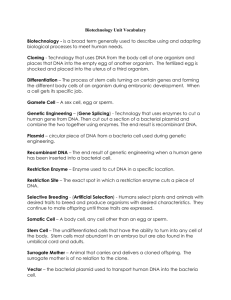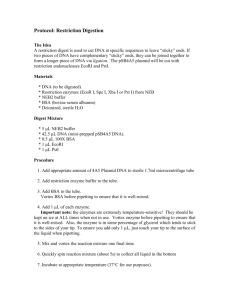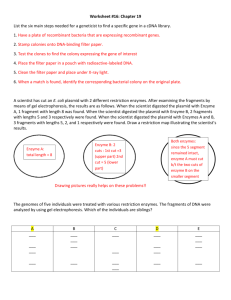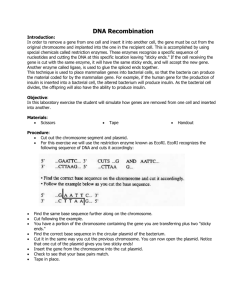Recombinant DNA Paper Plasmid Lab
advertisement
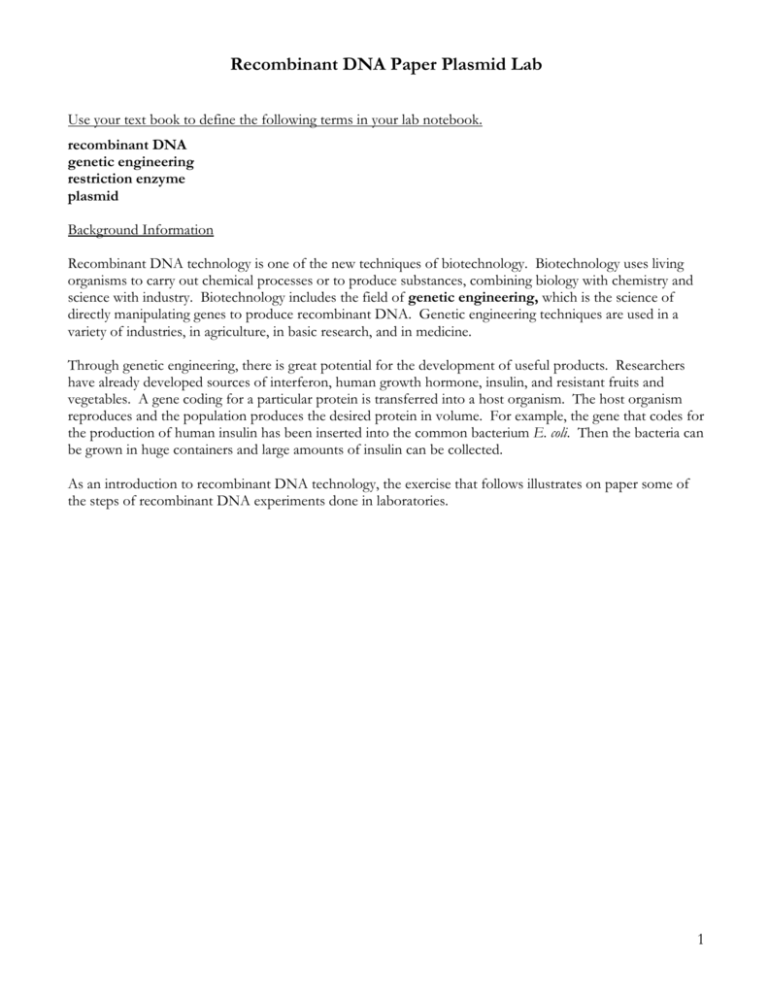
Recombinant DNA Paper Plasmid Lab Use your text book to define the following terms in your lab notebook. recombinant DNA genetic engineering restriction enzyme plasmid Background Information Recombinant DNA technology is one of the new techniques of biotechnology. Biotechnology uses living organisms to carry out chemical processes or to produce substances, combining biology with chemistry and science with industry. Biotechnology includes the field of genetic engineering, which is the science of directly manipulating genes to produce recombinant DNA. Genetic engineering techniques are used in a variety of industries, in agriculture, in basic research, and in medicine. Through genetic engineering, there is great potential for the development of useful products. Researchers have already developed sources of interferon, human growth hormone, insulin, and resistant fruits and vegetables. A gene coding for a particular protein is transferred into a host organism. The host organism reproduces and the population produces the desired protein in volume. For example, the gene that codes for the production of human insulin has been inserted into the common bacterium E. coli. Then the bacteria can be grown in huge containers and large amounts of insulin can be collected. As an introduction to recombinant DNA technology, the exercise that follows illustrates on paper some of the steps of recombinant DNA experiments done in laboratories. 1 Steps to Recombination 1. Scientists must first identify the gene that codes for the production of the protein they want to manufacture. 2. Next scientists must isolate the desired gene. Restriction enzymes from bacterial cells are important in this step. Each restriction enzyme recognizes and cleaves (cuts) a very specific sequence of DNA called a restriction site. Some restriction enzymes make a staggered cut of the DNA producing sticky ends or single strands of unpaired nucleotide bases capable of binding with complementary sticky ends. By using restriction enzymes that will cut the DNA on either side of the gene, the desired gene can be clipped out of the DNA strand. 3. Once the desired gene has been isolated scientists must then insert the gene into a plasmid. Plasmids are small circular pieces of DNA found naturally in most bacteria. The plasmid must be removed from a bacterium and cleaved with the same restriction enzyme used to isolate the gene. This way the sticky ends of the plasmid will match those of the gene. 2 4. Finally, bioengineers mix the plasmids with host bacteria. The recombinant plasmid is taken up by a host bacterium. Inside the bacterium, the plasmids replicate so that they exist in multiple copies. The gene becomes active and the bacteria begin producing the protein. 3 Procedure for Making a Paper Model of Recombinant DNA 1. Construct a plasmid. a. Cut out the plasmid strips along the dotted lines. b. Tape them together, end to end, in any order. c. Tape the two ends of the linear piece together to give the plasmid its circular shape. 2. Map the plasmid. a. b. c. d. Color the restriction site on each enzyme card with a different color. Cut the enzyme sheet into separate cards. Mark a starting point on the plasmid by drawing a circle around any base pair. Locate the restriction sites on the plasmid by comparing the sequence of base pairs on the enzyme cards with the sequence of base pairs on the plasmid. e. Mark as many restriction sites as possible by drawing a line along the plasmid restriction site which matches the line drawn on the enzyme card. Make certain that you use the same color as the enzyme card. Write the name of the restriction enzyme beside the cleavage site. 3. Construct the cell DNA and isolate the gene to be inserted into the plasmid. a. Leaving the numbers 1 through 6 on the bottom of each strip, cut out the strips on the cell DNA sheet. b. Assemble the strips in order by taping the top of strip 2 to the bottom of strip 1. Tape the top of strip 3 to the bottom of strip 2. Continue in this fashion until all 6 strips have been assembled into a chromosome strand. 4. Determine which restriction sites are near the protein gene and cleave with the restriction enzyme. a. The protein gene is marked like this: b. Choose a restriction enzyme that cuts your plasmid in only one place. Locate and mark that same restriction enzyme’s site above and below the gene by comparing the sequence of base pairs on the enzyme card with the sequence of base pairs on the cell DNA. c. Cut both the plasmid and the cell DNA along the same restriction enzyme site. The plasmid will be cut in one place and the cell DNA will be cut in two places. 5. Insert the gene into the plasmid. a. Match the sticky ends of the gene with those of the plasmid and tape the ends so that the gene is incorporated into the plasmid. b. You now have a recombinant DNA molecule composed of DNA from two different organisms. At this point in a recombinant DNA laboratory, the recombinant plasmids would be mixed with the host bacterial cells and could be screened for an antibiotic marker or for the expression of the inserted gene. 4


